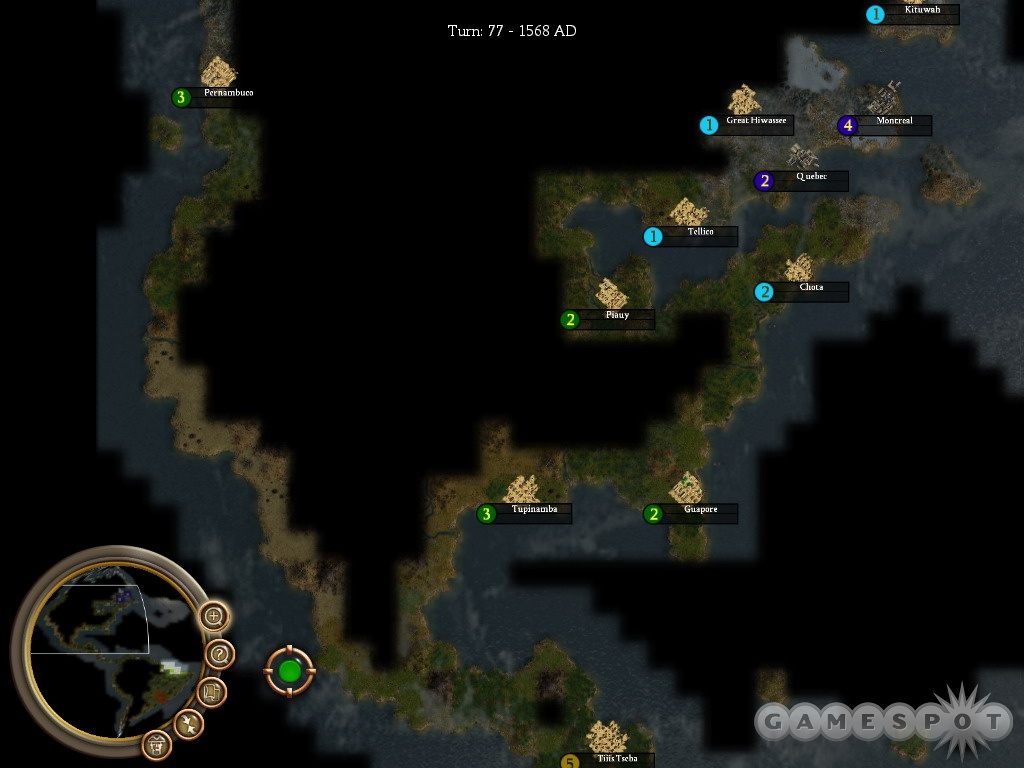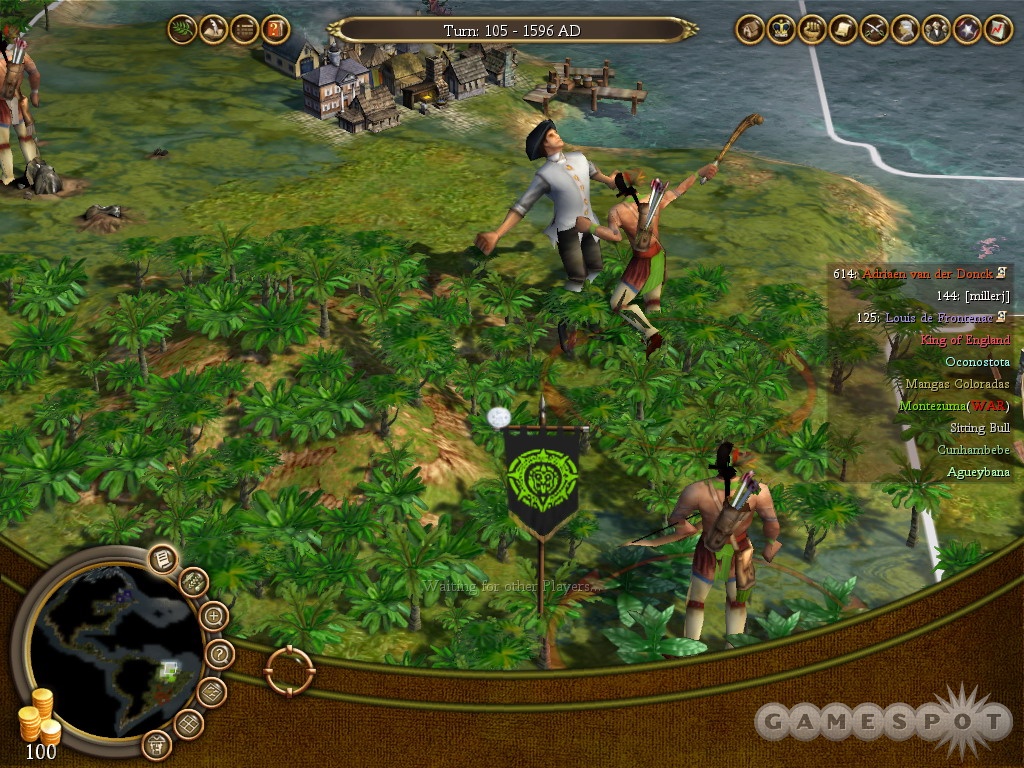Civilization Colonization Updated Hands-On
Welcome to one of the most challenging Civilization games to date. Viva la Revolution.
Civilization IV: Colonization proves that you don't need an advanced technology tree with the Manhattan Project or manned spaceflight to completely engross you in the latest entry from famed game designer Sid Meier. No, in Colonization, all you need is corn.
Early on in your quest to dominate the New World, cultivating food and growing your colony's populations will be your first priority. Armed conflict against hostile barbarians? Forget about it. Even your European rivals from either England, France, Spain, or the Netherlands don't want to pick a fight. Success in the Americas is based on your ability to adapt to new forms of agriculture, manage your relationship with Native American tribes, and generate enough resources to simply stay alive. Invading tiny Indian villages is the last thing you should worry about.

In our last hands-on with Colonization, we played through the single-player mode. In traditional Civ form, the maps are randomly generated to encourage surprise and exploration. There are two map types to choose from: New World, which generates two large land masses to represent North and South American; and Caribbean, which creates a series of islands meant to characterize Hispaniola and the islands in the Bahamas discovered by Columbus. This week, we played through one of the few maps included in Scenario mode. The new scenarios use maps based on real geography, something many Civ fans have been clamoring for for years now. One map focuses on North America, a second on South America, a third on the Northwest Passage and one giant map that spans the entire western hemisphere. Having aspirations for world domination, we obviously chose to play as the English and expand the empire from pole to pole.
It's important to note that unexplored areas of the map remain cloaked in darkness, so even though you know the basic geography of South America, exploration is still important. The tech tree and road to success in Colonization is unlike any other Civ game, unless you played the original Colonization from Sid Meier back in 1994. First up is food, represented on the map as corn and fish. Cultivating food is the key to growing your population, and you can recruit expert farmers or fishermen from your homeland in Europe who will double production when assigned to their respective specialties.
While the goal of Colonization is to break away from your European home country and declare your independence, Europe is an invaluable resource for almost the entire game. There's a market for raw materials, such as cotton, sugar, tobacco, and animal furs. Shuttling those goods back to the homeland will also give you gold to be spent on even more master craftsmen. Such craftsmen come in handy when you are established enough to begin refining your goods into coats, rum, cigars, and cloth, which are usually priced at more than four times the cost of the raw product. Cha-ching.
As many in Europe are persecuted for their religious beliefs, they look to the New World as a place of freedom, a fresh start. Often these disenfranchised citizens will be waiting at the docks in Europe to join your colony. While master craftsmen will double your production, indentured servants and petty thieves will also look to make the transatlantic voyage, so you'll have to decide if you want such low-producing citizens in your colonies. Give me your tired, your poor indeed. One way to increase the amount of quality immigrants is to establish churches and cathedrals within your colonies. These produce "crosses," and clergymen, such as firebrand preachers, can be assigned to work in a house of God to double the production of crosses. As a beacon of hope and religion, Europeans will begin flocking in no time.
When they do, education is a great way to get your masses learned in a specialization. By sending them to schoolhouses or college, colonists will learn specializations, such as master blacksmith, gunsmith, or carpenter, for example. Balancing all these raw materials is quite a chore. To build advanced structures, you need tools and lumber; to build tools, you need iron ore; to chop wood, you need lumberjacks; to feed miners and lumberjacks, you need food; and to cultivate food, you need farmers and fishermen. On the side, you also have tobacconists manufacturing cigars, distillers making rum, fur traders making coats, weavers making cloth, and gunsmiths making rifles that defend your villages. Carpenters increase the production speed of new buildings, wagon trains, and naval vessels. Naval vessels are used to shuttle materials between your cities and Europe by sea, while wagons transport goods overland.
If all this sounds like a lot, it is a lot. It's a bit surprising because Colonization is so narrow in scope compared to the Civ IV that encompasses most of human history. Colonization only takes place during a few hundred years and puts a heavy emphasis on resource management. Thankfully, the native tribes and rival European colonies aren't interested in war, at least not early on in the game. One of the final products you'll produce is guns, which are stockpiled in cities to be used as defense. The process of simply creating guns, cannons, and artillery is at the very end of the tech tree, but such items may not have even developed before your game ends. Even though the maps can be huge--we played for hours and only saw a fifth of the Northwest Passage map--valuable land is at a premium. To maintain your colonies, you'll also need to expand into the territory of native tribes. Slowly, the tension will build, and war will inevitably be upon you, whether you would risk it or not.
Once you finally stabilize your relationships, food production, wood production, ore production, tools production, refined goods production, and weapons production, you have created a successful network of colonies capable of joining together as a new nation. The only problem is that no one wants to rebel. Such sentiment is enhanced by filling your city halls with capable leaders, such as elder statesman who produce "liberty bells." Finally, when the majority of your citizens want to create a United States of America, you can rebel. A greedy king always demanding money and increasing your taxes doesn't help matters much, either.

If you're looking for a challenging Civ experience, Colonization is it. Management plays a much greater role than combat, and you can't simply fight your way to victory from the very beginning. We'll have more on Colonization soon as we examine multiplayer, community, and mod tools heading toward the September 22 scheduled release date; that is, if we can pry ourselves away from the extremely addictive single-player mode. Just one more turn? Yeah right.
Got a news tip or want to contact us directly? Email news@gamespot.com
Join the conversation